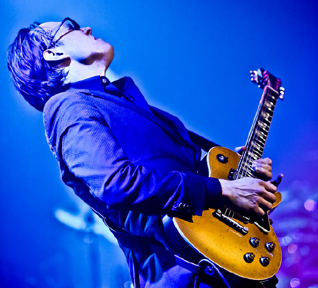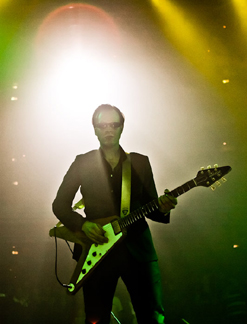Joe Bonamassa: The Quiet Prince

On Joe Bonamassa’s Beacon Theatre–Live from New York DVD, which came out earlier this year, there is a short, but telling, segment tucked away on the bonus disc. In “A Busker’s Tale,” he tells the Beacon Theatre crowd how, earlier in the day, he gone into a New York City subway station and played his guitar – and no one gave him any money. The story brings a big laugh from the theater packed with his fans; however, it also speaks to Bonamassa’s station in today’s music world. While he can fill up concerts with fans, he is still another Joe playing guitar to the general public.
Not that he hasn’t made a name for himself. His résumé contains a healthy list of honors: Guitar International’s 2011 “Guitarist of the Year,” “Breakthrough Artist of the Year” at the 2009’s Classic Rock Roll of Honour Awards in England and Billboard’s No. 1 Blues Artist of 2010. And he is a perennial winner in Guitar Player’s annual Readers’ Choice awards.
His guitar prowess has long attracted the attention of his peers. B.B. King had a 12-year-old Bonamassa open for him and musicians as diverse as Vince Gill, Stevie Winwood and Buddy Guy have been impressed enough to want to play with him. LA-based blues rocker Beth Hart, who collaborated with Bonamassa on 2011’s Don’t Explain, puts it this simply: “Working with Joe Bonamassa is like spending your whole life dreaming about working with a legend and then, suddenly, you realize that you have.” Eric Clapton, one of Bonamassa’s own guitar gods, has not only joined him onstage but also invited him to his prestigious guitar summit, Crossroads Festival.
A charismatic player, Bonamassa might be best known for his lightning-quick fretwork. But he also displays an ability to pull out gritty tones while displaying a liquid-y touch on top of a virtuosic versatility at handling blues, country and rock and roll. He can wander the back roads of Texas blues a la Stevie Ray Vaughn, get down and dirty with Mississippi Delta-rooted blues or plug into hard-driving blues rock inspired by Jimmy Page or Paul Kossoff.
Despite the mountain of accolades from critics and peers, Bonamassa’s public profile isn’t as high among even general rock fans as many of his fellow guitar stars playing today. He has had the big-name gigs like Warren Haynes and Derek Trucks have with The Allman Brothers Band and Grateful Dead (two bands with huge, multi-generational followings) yet he also remains in the shadow of two other hotshot blue guitar prodigies – Kenny Wayne Shepherd and Jonny Lang, who made their marks just before Bonamassa’s arrival on the scene.
You might think that this lack of recognition might make Bonamassa feel bitter or cynical, but that turns out to be far from the truth. When asked about the busking episode, Bonamassa laughs it off, describing it as a “fun experience.”
Having lived in New York, he knows how hard it is for performers to pry money out of the pockets of subway denizens. The fact that the concert that night featured a guest appearance from one of his singing idols, former Free and Bad Company frontman Paul Rodgers, helped balance out the subway incident.
Bonamassa, who now resides in Los Angeles, actually enjoys this level of anonymity, finding an upside to “my life on the E-list,” as he calls it. “I like that there are no TMZ vans outside my house,” he says. “I don’t do a rock star persona…I’m not interested in maintaining an image…I don’t get decked out in Versace to go to the 7-Eleven…I just play.”
And play he does. Glenn Hughes (of Deep Purple fame) proclaims that Bonamassa (his collaborator in the hard rock outfit Black Country Communion), “is only really interested in playin’ guitar.”
He could serve as the definition of a road warrior. His motto, in fact, is “Always on the Road,” a phrase that can be found on his tour bus and his T-shirts. He regularly racks up more than 100 gigs a year, traveling around the globe.
When he is not on the road touring for months at a time, he seems to be in the studio recording. In 2011 alone, he released three albums: a solo effort ( Dust Bowl ), the Beth Hart collaboration and the second Black Country Communion disc. This year, so far, he has put out Driving Towards the Daylight as well as the live DVD, although more is on the way. A second BCC album is set for a fall release and he recorded one of his concerts during a summer acoustic European tour. Oh, he also plans cut do another album with Beth Hart in January.

One reason that Bonamassa can do all of these projects is that he has been putting out his own product for years. J&R Adventures, his label/ management company, is a venture that he started with his manager Roy Weisman some years ago so that Bonamassa could be, in a sense, his own boss. This situation allows him the flexibility to do things that he wants to do, and, as he proclaims with a laugh, “Freedom is awesome!”
During a late summer break in touring, for example, he spent a week in the studio with his drummer, Tal Bergman, recording an album of instrumental funk music and he didn’t have to worry about label interference warning him that this project might be bad for his brand image.
J&R Adventures came out of necessity, Bonamassa admits, not because of a grand plan. “No one would freaking help out” to get on major label deal. The big labels, he says, all viewed him as someone who was still playing “BBQ joints and Holiday Inns.”
But he has had the last laugh. J&R now releases Bonamassa’s records, books the shows, sells merchandise and he controls his destiny more than if he were on a major label. While Bonamassa’s sales aren’t at Beyonce levels, his albums consistently top the Billboard blues charts and his latest release, Driving, reached No. 2 in the U.K., less than 100 copies from the highest spot. (Bonamassa modestly adds that it was the lowest selling week of the year.)
He openly acknowledges that his fans have helped him succeed and he is grateful for this support. In the ever-changing music business environment, Bonamassa views concerts as being critical to an artist’s success and says the recipe for a memorable gig is to put on an “honest and authentic” show because the “ticket-buying public is hip and savvy.”
He states that he knows how hard it is to play Peoria, Ill. on a Tuesday night, because he has performed for a handful of Peorians on a Tuesday night, and is “happy that I can now attract a couple thousand people to see me.”
In talking to Bonamassa, you get a sense that he doesn’t take his accomplishments for granted. To him, being a working musician is the definition of making it. When mentioning how lucky he is to be making a living as a musician, he talks about personally knowing talented but poor musicians who “who have to eke a living out playing $50 jingle sessions.”
Even after his many years of heavy touring and prolific recording, Bonamassa professes to have more enthusiasm now than a decade ago, and he has some good reasons, too.
In his younger days, he was struggling for his daily bread and now, he can not only afford his bread daily but also a house in Malibu, too. And when he goes to guitar store, he doesn’t have to just window shop.
Considering his renown among guitarists, it’s not surprising that Gibson has produced several Bonamassa Signature Les Paul models. An inveterate guitar collector himself, Bonamassa finds that this is an honor that is “pretty fantastic.” Gibson, however, wasn’t a Johnny-come-lately in courting Bonamassa. The fabled guitar company believed in him back in the day and signed him up early, which makes the business relationship feel organic to him.

When the 35-year-old Bonamassa says that he has spent 25 years building his career, it may sound hard to believe but he isn’t exaggerating. He got his first guitar before he started elementary school and was playing Hendrix while other kids will still playing T-ball. Before he reached 18, he was part of the rock band Bloodlines, which famously featured sons of Miles Davis, Berry Oakley and Robby Krieger.
While that band never hit it big, the young guitar whiz attracted attention and admirers. One of his early champions, the legendary Tom Dowd, produced his solo debut, A New Day Yesterday, which features guest appearances by musicians like Gregg Allman and Leslie West. Since his acclaimed debut, Bonamassa has seemed to be constantly busy – recording CDs, touring, releasing live albums or working on projects like Black Country Communion. (The rock supergroup includes drummer Jason Bonham and keyboardist Derek Sherinian besides Bonamassa and Hughes.) All told, he’s released 15 CDs and five DVDs since 2000.
Album by album, show by show, Bonamassa has steadily built his career in a workmanlike fashion. He even uses construction terms to describe his approach: It’s about “big foundation, not about walls and a roof.” The end result might not be something enormous – “world domination is not for us,” he asserts – but rather something rock-solid and built to last while allowing him to do many things.
His BCC buddy Hughes remarked via email that Bonamassa’s career route is attracting “one fan at a time,” adding that “his contribution and accolades will come over time, like all great American blues artists that came before him. He will take it to the streets and build yearly.”
Bonamassa’s blue-collar attitude to being a musician likely comes from the fact that music is his family’s business. His father Len Bonamassa owns a music store. Len, who also plays guitar, was the one who gave a young Joe his first guitar at the age of four. Bonamassa’s grandfather and great-grandfather were both trumpeters. As a child, consequently, he was able to hear, and absorb, a wide variety of music, which resulted in his varied musical interests now.
During his youthful musical education, Bonamassa was drawn to the sounds of the British blue rockers. He has said that he had a more immediate connection to than the traditional American bluesmen, who, of course, had inspired the English electric bluesmen.
*
Many of his blues-rock heroes – guys like Rory Gallagher, Paul Kossoff, Gary Moore and the American Roy Buchanan – were not only great guitarists but also, sadly, had their battles. Addiction lead them to early graves, while another major influence, Eric Clapton, nearly died from his struggle with drugs and alcohol.
Other significant guitar greats, like Peter Green and Danny Gatton, are known now as much for their wonderful playing as their struggles with their inner emotional demons. Gatton, who tragically took his own life, served as a teacher/mentor to the teenage Bonamassa, who has credited him with introducing him to genres outside of blues like country and jazz.
Bonamassa, however, comes off as too levelheaded to stumble into a tragic path that affected the lives of many of his guitar heroes. Maybe it is because he is a fourth generation musician, but Bonamassa understands the occupational responsibilities to a career in music.
Hughes says, “Joe has his feet firmly planted on the ground.” Bonamassa puts this way: “It’s a job (and) you can’t spend the day drinking and laying around and expect to keep your job – even in rock and roll.”

When asked about musicians whose careers he admires currently, Bonamassa quickly rattles off Slash, Chris Isaak, B.B. King and Eric Clapton. While the first two might be more surprising than the latter pair, he sees a common denominator to these four musicians: the authenticity in what they do. With Slash, for example, “he does what he does,” and, Bonamassa states that all of these guys create their work “unapologetically.”
Bonamassa places high value in this sense of artists having authenticity in their work. While he professes admiration for singers like Bono and Mick Jagger, he asserts, “I can’t see myself as a performer on a catwalk” like them. He believes that his music works best in smaller rooms than giant arenas and he doesn’t want to do something that feels disingenuous.
The guiding philosophy of “staying true to who you are” has taken Bonamassa to explore a variety of musical directions. As Hughes describes him, “Joe is focused, or he tries to be. He’s gonna do what he’s gonna do.”
While he is known for his muscular, bluesy guitar work, he explores a spectrum of styles (country, rock, R&B) seemingly effortlessly. He even talks about doing a jazz album some time in the future. His longtime producer Kevin Shirley (Rush, Iron Maiden, Black Crowes) proclaims that Bonamassa “can play any style you throw at him, which is amazing.”
His various musical explorations don’t seem to phase his fans, but Bonamassa believes that “they know I have many interests.” He has, however, spent years building a loyal grassroots following and maintaining a personal touch with the fans. This strong relationship pays off in ways like his recent Europe acoustic tour where Bonamassa was pleased to discover that audiences dug his renditions and that he didn’t need to do four-minute solos.
Bonamassa’s “if it feels right” attitude also has resulted in recording a diverse choice of cover songs. While you’d expect him to do tunes by blues masters like Robert Johnson and Willie Dixon or more British blues rockers such as Bad Company or the Jeff Beck Group, you will also see that Bonamassa has covered songs by Willie Nelson, Leonard Cohen, Broadway showman Anthony Newley and Rocky Horror star Tim Curry. Bonamassa explains that “good lyrics sell me on a song” so that he can make a connection.
Some of these cover songs will undoubtedly be part of the setlists for Bonamassa’s next major endeavor. At the end of March, he will go to London to play each of the venues he had performed at in the past, starting with The Borderline and moving up to the Shepherd’s Bush Empire, then the Hammersmith Odeon and culminating at the regal Royal Albert Hall. Each show, featuring a different band and material, will be recorded.
Bonamassa estimates that he will be rehearsing 90 songs for the quartet of concerts, which his producer Shirley describes as “groundbreaking.” However, it all just seems to fit into Bonamassa’s “if it feels right” approach to his career.



















